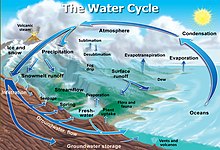User:IJThomas/sandbox
 | This is a user sandbox of IJThomas. You can use it for testing or practicing edits. This is not the sandbox where you should draft your assigned article for a dashboard.wikiedu.org course. To find the right sandbox for your assignment, visit your Dashboard course page and follow the Sandbox Draft link for your assigned article in the My Articles section. |
Science[edit]
Scientists study snow at a wide variety of scales that include the physics of chemical bonds and clouds; the distribution, accumulation, metamorphosis, and ablation of snowpacks; and the contribution of snowmelt to river hydraulics and ground hydrology. In doing so, they employ a variety of instruments to observe and measure the phenomena studied. Their findings contribute to knowledge applied by engineers, who adapt vehicles and structures to snow, by agronomists, who address the availability of snowmelt to agriculture, and those, who design equipment for sporting activities on snow. Scientists develop and others employ snow classification systems that describe its physical properties at scales ranging from the individual crystal to the aggregated snowpack. A sub-specialty is avalanches, which are of concern to engineers and outdoors sports people, alike.
Snow science addresses how snow forms, its distribution, and processes affecting how snowpacks change over time. Scientists improve storm forecasting, study global snow cover and its effect on climate, glaciers, and water supplies around the world. The study includes physical properties of the material as it changes, bulk properties of in-place snow packs, and the aggregate properties of regions with snow cover. In doing so, they employ on-the-ground physical measurement techniques to establish ground truth and remote sensing techniques to develop understanding of snow-related processes over large areas.[1]
Different measurement techniques are employed to study snow including: ground based sensors, aircraft mounted sensors and satellite measurements. On-the-ground measurements provide good temporal resolution, with the drawback that sensors must be installed and maintained, limiting the spatial resolution. Lidar (Light Detection and Ranging) is commonly mounted on an aircraft, providing good spatial resolution at a set time[2] Satellite measurements can have good spatial and temporal resolution but often are derived measurements, rather than direct.
Models[edit]

Snow science often leads to predictive models that include snow deposition, snow melt, and snow hydrology—elements of the Earth's water cycle—which help describe global climate change.[3]
Global climate models (GCMs) incorporate snow as a factor in their calculations. Some important factors of snow cover include its albedo (reflectivity of incident radiation, including light), aspect (compass direction that the slope faces), canopy, insulating qualities and elevation which all change the rate that the snow melts. Albedo and snow's insulating qualities slow the rate of seasonal melting of sea ice. As of 2011, the melt phase of GCM snow models were thought to perform poorly in regions with complex factors that regulate snow melt, such as vegetation cover and terrain. These models typically derive snow water equivalent (SWE) in some manner from satellite observations of snow cover.[3] The International Classification for Seasonal Snow on the Ground defines SWE as "the depth of water that would result if the mass of snow melted completely".[4]
Climate and weather models can incorporate ice phase precipitate, including snow. The inclusion of ice phase precipitate is important for modeling mesoscale features. Melting of ice phase particles cools its surroundings causing and maintaining downdrafts.[5] Some of the important variables of ice phase precipitate in models includes the form of the precipitate, fall speed and particle size.
Given the importance of snowmelt to agriculture, hydrological runoff models that include snow in their predictions address the phases of accumulating snowpack, melting processes, and distribution of the meltwater through stream networks and into the groundwater. Key to describing the melting processes are solar heat flux, ambient temperature, wind, and precipitation. Initial snowmelt models used a degree-day approach that emphasized the temperature difference between the air and the snowpack to compute SWE. More recent models use an energy balance approach that take into account the following factors to compute Qm, the energy available for melt. This requires measurement of an array of snowpack and environmental factors to compute six heat flow mechanisms that contribute to Qm.[3]
References[edit]
- ^ "All About Snow—Snow Science". National Snow and Ice Data Center. University of Colorado, Boulder. 2016. Archived from the original on December 1, 2016. Retrieved November 30, 2016.
- ^ "What is lidar?". Retrieved December 11, 2020.
- ^ a b c Cite error: The named reference
Snowenclyclopediawas invoked but never defined (see the help page). - ^ Cite error: The named reference
Classificationongroundwas invoked but never defined (see the help page). - ^ Lord, Stephen J. (1984). "Role of a Parameterized Ice-Phase Microphysics in an Axisymmetric Nonhydrostatic Tropical Cyclone Model".
{{cite journal}}: Cite journal requires|journal=(help)
